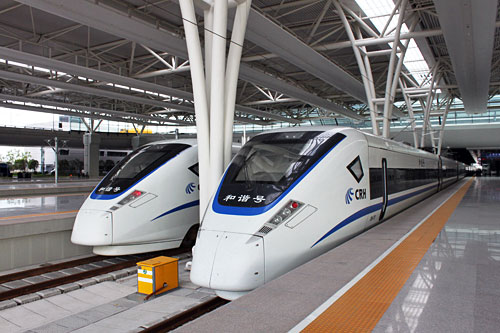Though my original plans called for me to take the night train from Shanghai to Beijing to meet up with my cousins in preparation for sleeping on the Great Wall of China, it was just not meant to be. For two days I schlepped back and forth between my hostel and three different train station ticket offices, carrying a series of hand-written Chinese notes explaining what I needed, only to be met with what I have since learned is the most classic of Chinese responses: “mei you” which means “not have.” In desperation, I begged the assistance of Concierges at nearby international hotel chains and visited huge Chinese travel agencies around People’s Square, but by the time I finally found the only person who spoke enough English to help me, the tickets for the night I needed to travel were totally sold out. This is a common occurrence; apparently there are many students who travel back and forth between Shanghai and Beijing for University, and the tickets sell out fast, with the soft sleepers and soft seats going first, followed by the hard sleepers and hard seats.
In Beijing, I was quick to advise my cousins about the situation, so upon checking into our hostel we immediately asked the front desk clerk about getting tickets for the train back to Shanghai three days hence. Unlike the hostel in Shanghai, this clerk picked up the phone and called for us; there were only five tickets left and while we were discussing whether or not to take them, two more sold. Without further hesitation, we snapped up the remaining three, even though it meant we would be traveling in three different rail cars.

On the day of our departure, we checked out as late as possible and hauled our luggage down 50+ stairs to the subway, changed lines and carted the suitcases up and down more steps, and then clunked up another three flights of stairs at our final destination, the ultra modern Shanghai Hongqiao Railway Station. We had purchased tickets for the ultra-fast bullet D-Train, which makes the run between Shanghai and Beijing in just ten hours (as opposed to Z-trains, which take 12 hours; T-trains, which require 13.5 hours to make the run; K-trains, which are 19-hour long rail trips; and any number of other slower trains that have no letter before their name and require 20 or more hours).
We had a few hours to kill before departure, but that turned out to be fortunate, since it gave us plenty of time to figure out how the boarding system works. All passengers wait in the ultra-modern main terminal building, in the center of which are hundreds of seats ranging from wooden chairs surrounding small round tables to overstuffed armchairs, with one section of the waiting room even offering cushy sofas surrounding a piano bar. Both sides of the central waiting area are lined with a series of glass-door “gates” that resemble subway entrances. When boarding is called, about half an hour prior to departure, the glass doorways open to reveal an escalator that descends to the train platforms below. Passengers insert their tickets into one of the automatic ticket reading machines (just like those found in the New York subways) and go through a turnstile to the escalator. The only tricky part is figuring out the gate from which you will be departing; although announcements are in both Chinese and English, they are slightly confusing because the beginning of each announcement instructs passengers to go to a specific numbered terminal, which bears no relationship to the gate number from which the train actually leaves. We eventually figured out that the “ticket check” number at the end of each announcement was the gate at which we needed to queue.
Our train was announced right on time and we joined the crush of passengers jockeying for position in front of the turnstiles. Once we got through and were on the escalator, the rest was a breeze. The cars are well marked and the platform is brand spanking new, with great directional signs. We found our respective cabins and I settled in for the long ride in my top berth, expecting discomfort. Instead, I found a comfortable, wide bed that was fairly easy to climb up into, with a fluffy pillow, a thick duvet, and an LCD flat-screen TV with headphones at the foot of my berth. Before long we were pulling out of the station and again I was surprised. I had expected the “clickety-clack of the railroad track” but the bullet train moved off with an almost silent whoosh and accelerated to a whisper-whine that reminded me of LeMans race cars whooshing around a racetrack.
I slept like a baby, lulled to sleep by the sonorous background noise and gentle rocking motion that was like floating on air, waking as the first morning light came through the window. At 660 RMB (about $100 US) it was a pricey ride, but still less expensive than flying and well worth the price for the experience of riding one of the world’s most modern trains.

It is the most convenient way connecting Shanghai and Beijing besides by flight. The train is convenient with all necessart amenities.
What is the speed of this train ??
Don’t know the speed, but it moves pretty fast, especially since it
completes the route in half the time of regular trans.
quite exciting journey ?
Absolutely, Dela. Best train ride I’ve ever taken.
Thanks Barbara! I’m always inspired by train travel stories.